PROMETHEE
This is a method from the family of outranking (i.e. based on pair-wise comparison) MCDA methods.
PROMETHEE stands for Preference Ranking Organization METHod for Enrichment Evaluation
Notation:
- $A = {a_1, …, a_n}$ - set of alternatives
- $F = {f_1, …, f_q}$ - set of criteria (assume we maximize everything)
Note that since we perform pair-wise comparisons, it may become computationally very expensive
There are four steps:
- Compute Uni-Criterion Preferences
- Compute Preference Matrix
- Compute Net-Flow Scores
- Rankings
- Complete: PROMETHEE II
- Partial: PROMETHEE I
Parameters for a problem (a decision maker needs to specify them)
- the type of preference function $P_k$ used for each criterion $f_k$
- weight $w_k$ for each criterion $f_k$
Uni-Criterion Preferences
we calculate the differences in all criteria for all pairs of alternatives:
- $\forall a_i, a_j \in A: d_k(a_i, a_j) = f_k(a_i) - f_k(a_j)$
- since we assume that we maximize everything, the bigger the difference, the better the first alternative is
The resulting value should be normalized:
- we apply a (pre-defined for each criteria $f_k$) preference function $P_k$ to each difference
- $\pi_k = P_k \big[ d_k(a_i, a_j) \big]$
- this transforms the difference into the preference degree
Preference Functions
There are 6 preference functions:
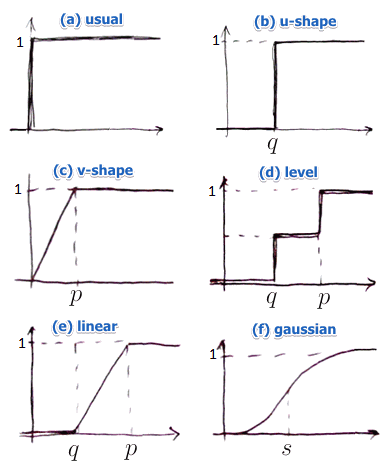
Basic Shapes
- (a) usual preference function
- as soon as see any difference, the preference is 1
- no need to specify any parameters
- this function is very sensitive
- (b) $u$-shape function
- difference needs to exceed a certain threshold $q$
- (a) and (b) are typically used for qualitative scales
- (c) $v$-shape
- with strong preference threshold $p$
- (d) level
- (e) linear
- same as (c) but with sensitivity threshold $q$
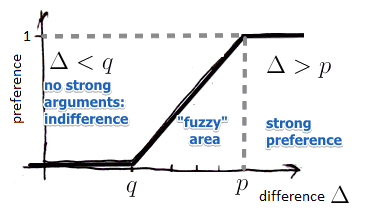
- (f) $v$-shape
Choosing a shape is already a decision
Preference Matrix
At this step we compute global preference degrees
- that is, for each pair $a_i, a_j$ compute:
- $\pi(a_i, a_j) = \sum_{k=1}^q w_k \cdot \pi_k (a_i, a_j)$
- global preference degree is a weighted sum of uni-criteria preferences
Consequences:
- $\pi(a_i, a_i) = 0$
- the preference of element $a$ with itself is always 0
- $\pi(a_i, a_i) = \sum_{k=1}^q w_k \cdot \pi_k (a_i, a_i) = \sum_{k=1}^q w_k \cdot P_k \big[ \underbrace{d_k(a_i, a_i)}_{= \ 0} \big] = 0$
- $\pi(a_i, a_j) \geqslant 0$
- the preference degree is always positive
- $\pi(a_i, a_j)$ is a weighed sum of $\pi_k$ which are always positive
- this is because the preference functions always return positive values
- $\pi(a_i, a_j) + \pi(a_j, a_i) \leqslant 1$
- ’'’todo’’’
Net Flow Scores
For each $a_i, a_j \in A$ we compute net flow scores
- $\Phi^+(a_i) = \cfrac{1}{n-1} \sum_{a_j \in A} \pi(a_i, a_j)$
- '’positive outranking net flow’’
- “strengths” of an alternative, how an alternative outranks others
- want to maximize it
- $\Phi^-(a_i) = \cfrac{1}{n-1} \sum_{a_j \in A} \pi(a_j, a_a)$
- '’negatives outranking net flow’’
- “weaknesses” of an alternative, how an alternative is outranked by others
- want to minimize it
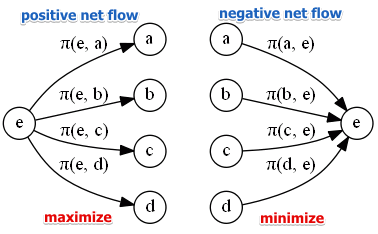
The values are normalized:
- $\Phi^+(a_i) \in [0, 1]$ and
- $\Phi^-(a_i) \in [0, 1]$
The flow score is computed as difference between the positive flow and negative flow
- $\Phi(a_i) = \Phi^+(a_i) - \Phi^-(a_i) \in [-1, 1]$ and
'’Uni-criteria flow’’
- flow computed with respect to only one criteria $f_k$
- $\Phi_k(a) = \cfrac{1}{n-1} \sum_{b \in A} [ P_k(a, b) - P_k(b, a) ]$
Ranking
PROMETHEE I
Partial Order Ranking:
- ranking based only on $\Phi^+(a_i)$ and $\Phi^-(a_i)$ (not on the aggregated flow score)
- let $P^+$ denote the preference of $\Phi^+$
- $a_i \ P^+ \ a_j \iff \Phi^+(a_i) > \Phi^+(a_j)$ (want to maximize $\Phi^+$)
- let $P^-$ denote the preference of $\Phi^-(a_i)$
- $a_i \ P^- \ a_j \iff \Phi^+(a_i) < \Phi^+(a_j)$ (want to maximize $\Phi^-$)
- $a_i \ P \ a_j \iff a_i \ P^+ \ a_j \land a_i \ P^- \ a_j$
- i.e. $a_i$ is preferred to $a_j$ only in case of Unanimity between $\Phi^+$ and $\Phi^-$
- if there is no unanimity, $a \ J \ b$
- $a$ is not comparable to $b$
- in this case it’s up to the decision maker to decide what to do with these alternatives
PROMETHEE II
This gives a completely ordered preference structure
- i.e. there’s no $J$ relation
Define:
- preference as $a_i \ P \ a_j \iff \Phi(a_i) > \Phi(a_j)$
- indifference as $a_i \ I \ a_j \iff \Phi(a_i) = \Phi(a_j)$
These relations are transitive and complete
Properties
Justification
; The PROMETHEE property:
- the netflow score $\Phi(a_i)$ is a centered score $s_i$ ($\forall i$) that minimizes the following $Q$:
- $Q = \sum_{i=1}^n \sum_{j=1}^n \big[ (s_i - s_j) - (\pi_{ij} - \pi_{ji}) \big]^2 $
- i.e. $Q$ is the sum of squared deviation and we want to minimize it
- proof: PROMETHEE/Properties#The PROMETHEE Property
Property 1
; $\Phi(a_i) \in [-1, 1]$ Easy to see that by the way we construct $\Phi(a_i)$
Property 2
Want to show that $\sum_{i = 1}^N \Phi(a_i) = 0$
- $N$ - the number of alternatives
- that can be shown by induction
- proof: PROMETHEE/Properties#Property 2
Preferential Independence
PROMETHEE respects the Preferential Independence hypothesis
Arrow’s Impossibility Theorem
Recall that according to the theorem all 5 conditions cannot be satisfied at the same time.
- Independence to Third Alternatives, due to pair-wise comparisons is not respected (shown below in PROMETHEE/Rank Reversal)
- but it satisfies all the rest
- The Monotonicity property is satisfied PROMETHEE/Properties#Monotonicity
Rank Reversal
A rank reversal happens if:
- $\pi_{ij} \geqslant \pi_{ji}$ but in spite of that $\Phi(a_i) \leqslant \Phi(a_j)$
- the main article: PROMETHEE/Rank Reversal
GAIA
PROMETHEE gives you scores and you can compute complete and partial rankings
- GAIA is a tool for visualizing, complimentary to PROMETHEE
- GAIA = Geometrical Analysis for Interactive Assistance
We can represent each alternative as a vector:
- we can represent an alternative as a vector of $q$ components:
- $[f_1(a_i), …, f_q(a_i)]$
- but in this space we have different scales - and things are not easy to compare
- we can use the netflow score, which is a value in $[-1, 1]$
- $\Phi(a_i) = \sum_{k=1}^{q} w_k \cdot \phi_k(a_i)$
- where $\Phi_k(a_i) = \cfrac{1}{n-1} \sum_{a_j \ne a_i} \big[ \pi_k(a_i, a_j) - \pi_k(a_j, a_i) \big] $
- so we can represent every alternative $a_i$ as a vector $[\Phi_1(a_i), …, \Phi_k(a_i)]$ in $q$ dimensional space.
But $q$ dimensional space is really hard to visualize
- GAIA does that
- it applies Principal Component Analysis for projecting $q$-dim space to 2-dim space
$\delta$
- some information is lost during the projection, and the $\delta$ coefficient shows how much information is retained on the plane
- $\delta$ is the ratio between the projected variance and the initial variance
- $\delta \geqslant 70\%$ is good
Example
Consider a “Buying a new car” example (from D-Sight [http://www.d-sight.com/learning-center/articles/buying-new-car])
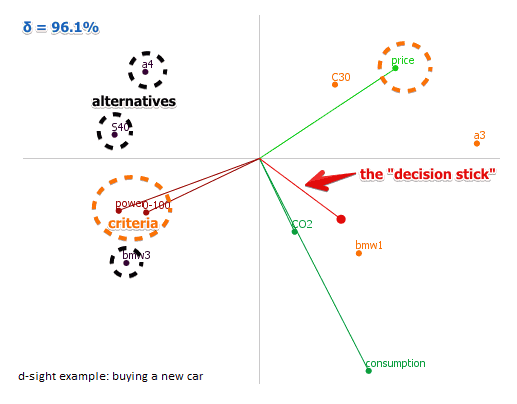
- points are alternatives
- lines with points at the end are criteria
- the red stick is a ‘‘decision stick’’ - the projection of weights to the plain
Based on a GAIA plane can make some observations:
- there are conflicting criteria: ones that point in the opposite directions
- there are also criteria that are in synergy: they point in the same direction

- some criteria are close to each other in 2-dim space - they also must be close in the $q$-dim space, so they should have similar profiles
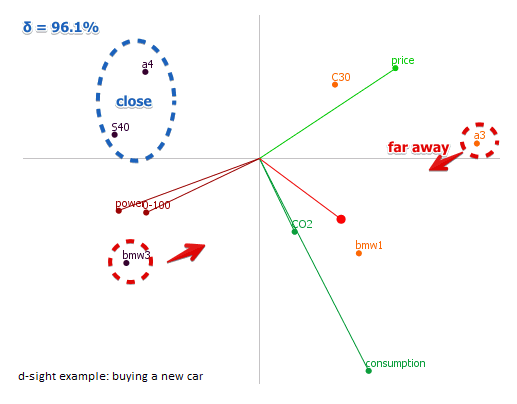
- it is also interesting to see the position of alternatives with respect to criteria: to project each as see which one is the best, worst, etc
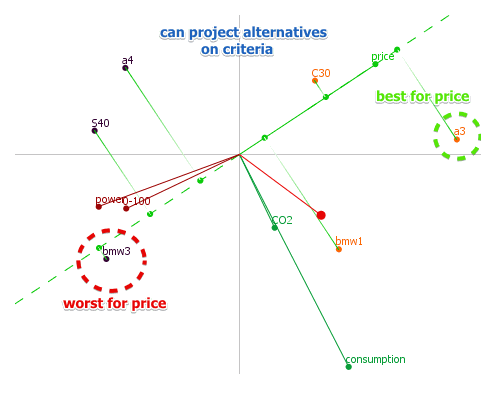
- and finally, the projection on the decision stick vector shows what are the best alternatives
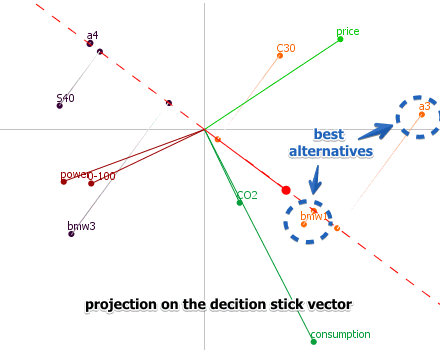
Example: Plant Location Problem
Evaluation Table
First we establish the following evaluation table:
| | # engineers | power | cost | maintenance | village | security | Italy | 75 | 90 | 600 | 5.4 | 8 | 5 || Belgium | 65 | 58 | 200 | 9.7 | 1 | 1 || Germany | 83 | 60 | 400 | 7.2 | 4 | 7 || Sweden | 40 | 80 | 1000 | 7.5 | 7 | 10 || Austria | 52 | 72 | 600 | 2 | 3 | 8 || France | 94 | 96 | 700 | 3.6 | 5 | 6 || | min | max | min | min | max | max |
-
red
color - worst value in column
-
blue
color - best value in column
Pair-wise Comparison
- start with 2 alternatives and consider only 1 criteria at a time
- for example, $G$ermany and $A$ustria:
- cost is better in $G$: 400 vs 600
- what does it mean?
- need to normalize this difference to [0, 1] scale - to be able to qualify the difference
| Unic. pref | 0.25 | -200 | Germany | 83 | 60 | 400 | 7.2 | 4 | 7 | Engineers | Power | Cost | Maint. | Village | Security | Austria | 52 | 72 | 600 | 2 | 3 | 8 | -31 | 12 | -5.2 | -1 | 1 | Unic. pref | 1 | 0.75 | 1 | 0.3 | 0.63 |
Global Preference Degree
Next step: compute global preference degree for all pairs of alternatives
- assuming a decision maker provides the weights
- eng: 0.1, pow: 0.2, cost: 0.2, maint: 0.1, village: 0.15, security: 0.15 (sum = 1)
- $\pi(A, G) = 1 \cdot 0.1 + 0.75 \cdot 02 + 1 \cdot 0.1 + 0.3 \cdot 0.15 + 0.63 \cdot 0.15 = 0.498$
- $\pi(G, A) = 0.25 \cdot 0.4 = 0.05$
- the closest the $\Pi$ value to 1, the move preferred one alternative to another is
We do this for all pairs and build a preference matrix
| Italy | Belgium | Germany | Sweden | Austria | France | Italy | 0 | 0.28 | 0.23 | 0.24 | 0.09 | 0.22 | Belgium | 0.27 | 0 | 0.4 | 0.3 | 0.27 | 0.5 | Germany | 0.22 | 0.19 | 0 | 0.3 | 0.05 | 0.43 | Sweden | 0.43 | 0.55 | 0.33 | 0 | 0.25 | 0.25 | Austria | 0.46 | 0.55 | 0.49 | 0.34 | 0 | 0.46 | France | 0.23 | 0.4 | 0.26 | 0.39 | 0.12 | 0 |
Net Flow Scores
Next we compute the positive and negative net flow scores:

- positive flow: strengths, has to be maximized
- negative flow: weaknesses, has to be minimized
Then we calculate if on average $G$ is better than the rest:
- $\Phi^+(G) = 0.238$ (avg of all $\Pi(G, X)$)
- $\Phi^-(G) = 0.334$ (avg of all $\Pi(X, G)$)
- the total score: $\Phi(G) = \Phi^+(G) - \Phi^-(G) = -0.1 \in [-1, 1]$
PROMETHEE II ranking
: ranking the alternatives based on their netflow scores
| rank | alternative | $\Phi(G)$ | $\Phi^+(G)$ | $\Phi^-(G)$ | 1 | Austria | 0.302 | 0.458 | 0.156 | 2 | Sweden | 0.049 | 0.363 | 0.314 | 3 | Belgium | -0.041 | 0.347 | 0.397 | 4 | Germany | -0.096 | 0.238 | 0.334 | 5 | France | -0.099 | 0.274 | 0.373 | 6 | Italy | -0.115 | 2.11 | 0.326 |
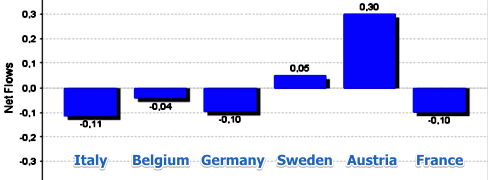
Note that this is a complete ranking:
- you can always say which alternative is better
PROMETHEE I ranking
| | $\Phi^+$ | $\Phi^-$ | $a$ | 0.8 | 0.1 || $b$ | 0.5 | 0.05 || $c$ | 0.1 | 0.8 | for both $\Phi^+$ and $\Phi^-$ (applying the Unanimity principle)
- $a \ P \ c$
- $b \ P \ c$
Cannot say anything about $a$ and $c$
- for $\Phi^+$: $a \ P \ b$
- for $\Phi^-$: $b \ P \ a$
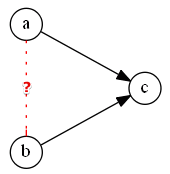
Sources
- Decision Engineering (ULB)
- An Introduction to Multicriteria Decision Aid: The PROMETHEE and GAIA Methods, Yves De Smet, Karim Lidouh, 2013